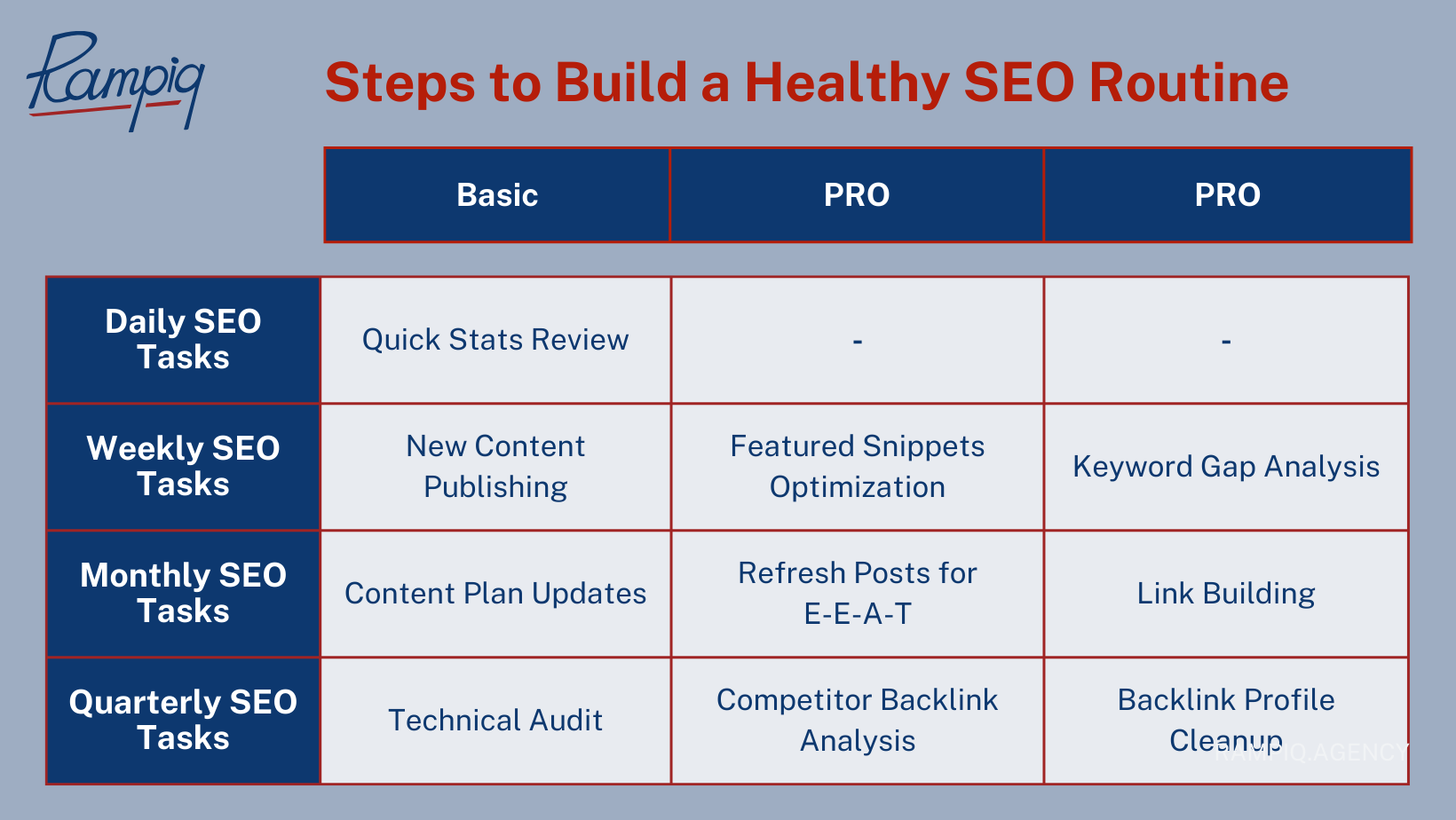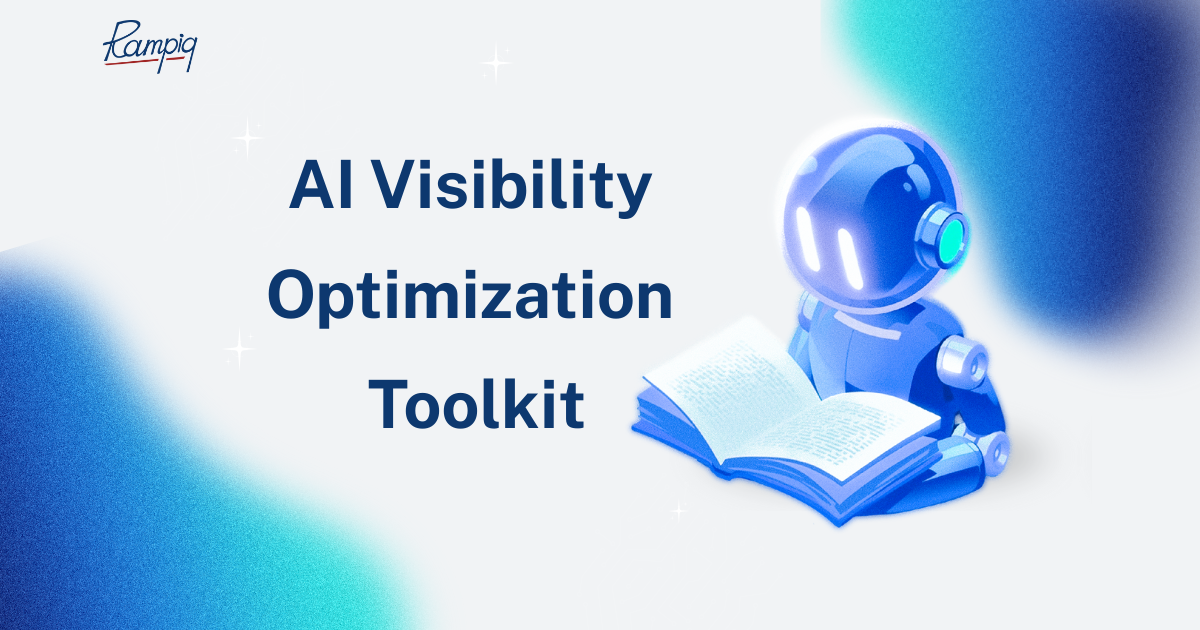Steps to Build a Healthy SEO Routine
Daily SEO Tasks
Basic: quick stats review
Begin with a quick review of your website’s key metrics to gauge your SEO health. Monitoring aspects like traffic sources, page views, bounce rates, and conversion rates provides insights into your website’s performance and areas for improvement. Tools like Google Analytics 4 and Google Search Console offer daily insights that can inform your broader SEO and content strategies.
While these platforms are instrumental in identifying trends and tracking user behavior, third-party tools can complement them by offering a more detailed analysis of other aspects. For instance, TopVisor lets you automate keyword ranking tracking, and Semrush, Ahrefs, Moz, etc. are essential for keyword research.
Weekly SEO Tasks
Basic: new content publishing
Consistently publish new content as this is crucial for maintaining and improving your organic visibility. High-quality, relevant content tailored to your B2B audience engages readers and also attracts search engine attention.
When it comes to publishing, there’s no recommended number of content to be published. However, it’s worth noting that publishing should be consistent, and a high content velocity can move the needle.
Here are some tips for creating impactful content:
- Understand Your Audience: Research your audience’s needs and pain points to create content that offers real solutions.
- Keyword Research: Use keyword research tools to identify terms your audience is actively searching for and guiding your content topics around them.
- Quality Over Quantity: Prioritize the creation of well-researched and comprehensive content that genuinely adds value.
- Optimize for SEO: Incorporate SEO best practices, such as using relevant keywords throughout your content, crafting compelling meta descriptions, and employing strategic title tags.
- Promote Your Content: Amplify your content’s reach by repurposing and sharing them to relevant websites in your industry, across social media platforms, email newsletters, and other relevant channels. For instance, sharing your guide on improving remote team productivity on LinkedIn can attract more views from professionals who may benefit from your insights. This also goes a long way in establishing you or your brand as an industry thought leader.
PRO: featured snippets optimization
Featured snippets are short excerpts from web pages that appear at the top of Google’s search engine results pages (SERPs), designed to quickly answer a searcher’s query.
Often referred to as ‘position zero,’ these snippets can significantly boost your website’s visibility by placing your content above the first organic search result.
Here’s how you can enhance your content for featured snippets:
- Analyze Existing Featured Snippets: Examine the length, format, and terms used in snippets currently capturing the spot you want.
- Structure Your Content Appropriately: Adapt your content to fit the common formats of featured snippets, such as lists, paragraphs, or tables.
- Answer Questions Directly: Structure answers to potential questions clearly and concisely within your content.
- Improve SERP Descriptions: Ensure your SERP descriptions (which may differ from your meta description) are accurate and enticing.
- Utilize Structured Data: Implement structured data to help search engines understand and display your content in snippet form.
PRO: keyword gap analysis
This means identifying and targeting keywords that your competitors rank for but your website does not.
The process can uncover new opportunities for your SEO strategy. Here’s how to conduct a keyword gap analysis:
- Competitor Analysis: Use SEO tools, such as Semrush or Ahrefs to identify which high-value keywords your competitors rank for that you haven’t targeted yet.
- Content Creation: Develop content that addresses these gaps, focusing on providing unique value and insights not found on competitor websites.
- Monitor Performance: Track the performance of your new content and adjust your strategy based on the results.
Incorporating these weekly tasks into your SEO routine ensures your strategy remains dynamic and responsive to both your audience’s needs and search engine trends. By balancing basic and PRO tasks, you can steadily improve your website’s SEO performance and online visibility.
Monthly SEO Tasks
These tasks are designed to refine your approach, keeping your content fresh and your backlink profile strong.
Basic: content plan updates
Once a month is an okay interval for creating or enhancing your content plan to ensure your strategy stays ahead of the curve.
This involves adding fresh topics informed by the latest market trends and audience insights, as well as tweaking existing, unpublished topics to enhance relevance.
This involves using insights from your website’s performance, industry trends, keyword research, and competitor analysis to guide content updates and new topic selection.
PRO: refresh posts for E-E-A-T (Expertise, Experience, Authoritativeness, Trustworthiness)
E-E-A-T is becoming increasingly important in SEO. We recommend that you regularly check your existing content and overall website for content that you can improve your demonstration of expertise, experience, authority, and trustworthiness.
Techniques to enhance E-E-A-T include:
- Update for Accuracy: Review and update your content regularly to ensure it reflects the latest industry standards and information.
- Showcase Expertise: Emphasize the qualifications and expertise of content authors or contributors. Include an ‘About Us’ page and detailed ‘Author Pages’ that link to external profiles, demonstrating their credentials and authority in the field.
- Incorporate Authoritative Sources: Link to reputable sources to bolster the authoritativeness of your content.
- Improve User Experience: Ensure content is easy to read, navigate, and understand.
- Leverage Schema Markup: Use schema markup to include the ‘sameAs’ property, linking to authors’ external profiles and authoritative sources.
PRO: link building
Backlinks can be seen as a vote of confidence for your website. High-quality backlinks are essential, as they serve as endorsements from reputable, high-authority websites within your industry.
The accumulation of these votes tells search engines that your content is relevant and authoritative in its field, which is critical for improving your website’s visibility and ranking.
In 2024, link building continues to be a fundamental aspect of SEO, significantly impacting how search engines evaluate the quality and relevance of your website. These signal to search engines the credibility and value of your content, and links with the dofollow tag can pass PageRank to your website from the linking website, boosting your website’s credibility and also enhancing its search ranking and visibility to potential visitors.
But what is a high-quality backlink?
High-quality backlinks are links from reputable websites in your niche or industry with excellent SEO metrics. These websites typically do not engage in illegitimate (blackhat) SEO practices, especially, in this context, trading backlinks.
Some of the most efficient link-building techniques are:
- Guest blogging on reputable websites
- Resource page link building
- Unlinked brand mentions
- Niche directory link building
- Creating linkable and shareable content
- Participating actively in industry forums and discussions
Conversely, it’s important to avoid detrimental practices such as buying links or engaging in link schemes that contravene search engine guidelines.
These shortcuts can lead to penalties like manual actions and diminish the long-term credibility and ranking of your website. A quick way to find backlink opportunities is by analyzing your competitors’ existing links. We will discuss more on this later in this guide. Keep reading.
Quarterly SEO Tasks
These tasks ensure your website’s long-term health and competitiveness. and allow you to address foundational aspects of your website’s SEO.
PRO: technical audit
A technical SEO audit uncovers issues that could be hindering your website’s performance, which can in turn impact organic visibility.
It involves a comprehensive check of your website’s technical health. Fix issues identified to ensure that your website is optimized for search engines and user experience. Tools like Screaming Frog, SEMrush, and Ahrefs offer powerful capabilities for conducting effective technical audits.
A thorough technical audit checks for:
- Site Speed: Fast loading times are imperative for user experience and SEO. According to Google, a one-second delay in page load time can lead to around 7% reduction in conversions. Hence, ensuring your website loads quickly is crucial for keeping users engaged and driving conversions.
- Mobile Responsiveness: With over 54% of global internet traffic coming from mobile devices, having a website optimized for mobile is a must. Google’s mobile-first indexing means websites optimized for mobile have a better chance of ranking higher.
- Crawl Errors: Search engines must be able to crawl your website effectively to avoid indexing issues. Regularly identifying and fixing broken links, crawl blocks, and improving user navigation ensure search engines can index your content properly.
- Duplicate Content: Exact and near duplicate content within the same website can confuse search engines and users, affecting your website’s SEO performance by diluting its relevance. Regularly audit your website for duplicate content and implement solutions like differentiating this content, merging and redirecting duplicates, or implementing canonical tags to show your preferred version
- Security Issues: Search engines tend to favor websites that adopt comprehensive security practices, not limited to HTTPS. This is not limited to search engine visibility but also user trust. For instance, browsers these days may alert users when they visit low-trust websites. Even without this, users will naturally not trust websites that seem unsafe. Getting your website’s security in order contributes to a safer browsing experience, reinforcing to search engines and users that your website is trustworthy and safe.
PRO: competitor backlink analysis
Dive into what makes your competitors stand out by studying their backlinks. This process helps spot potential partners and authoritative websites in your industry that may link to you too. Use tools like Ahrefs and Majestic SEO to get a peek at their link strategy. This insight helps you tweak yours for better results.
PRO: backlink profile cleanup
Maintaining a clean backlink profile is essential for safeguarding your website’s reputation with search engines. Over time, you might acquire backlinks from dubious sources that harm your website’s SEO. Conduct a regular audit of your backlink profile to identify and remove toxic links. The Google Disavow Tool allows you to formally disassociate your website from harmful backlinks, helping to maintain your website’s health and credibility.
Incorporating these quarterly tasks into your SEO strategy ensures your website remains in optimal condition, capable of achieving and maintaining high rankings in search engine results.









